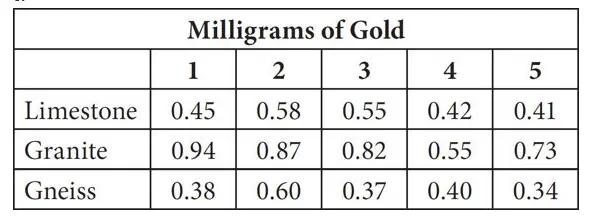6. A total of 140,000 votes were cast for two candidates, Skinner and Whitehouse. If Skinner won by a ratio of 4 to 3, how many votes were cast for Whitehouse?
A. 30,000
B. 40,000
C. 60,000
D. 80,000
7.

The owner of a spice store buys 3 pounds each of cinnamon, nutmeg, ginger, and cloves from distributor D. She then sells all of the spices at $2.00 per ounce. What is her total profit, in dollars?
(1 pound = 16 ounces)
A. $192
B. $282
C. $384
D. $486
8.

Five samples of each of three different rock types were collected on a hiking trip in Colorado. Each sample was analyzed for its gold content. The milligrams of gold found in each sample are presented in the table above. What is the percent difference of the average gold content in the granite samples when compared to the average gold content of the gneiss samples?
A. The gold content in the gneiss samples is 62% higher than the gold content in the granite samples.
B. The gold content in the granite samples is 62% higher than the gold content in the gneiss samples.
C. The gold content in the gneiss samples is 87% higher than the gold content in the granite samples.
D. The gold content in the granite samples is 87% higher than the gold content in the gneiss samples.
9. Of all the houses in a certain neighborhood, 80% have garages. Of those houses with garages, 60% have two-car garages. If there are 56 houses with garages that are not two-car garages, how many houses are there in the neighborhood?
A. 93
B. 117
C. 156
D. 175
10. On Tuesday, a watchmaker made 4 more watches than he made during the previous day. If he made 16% more watches on Tuesday than on Monday, how many watches did he make on Tuesday?
A. 20
B. 21
C. 25
D. 29
